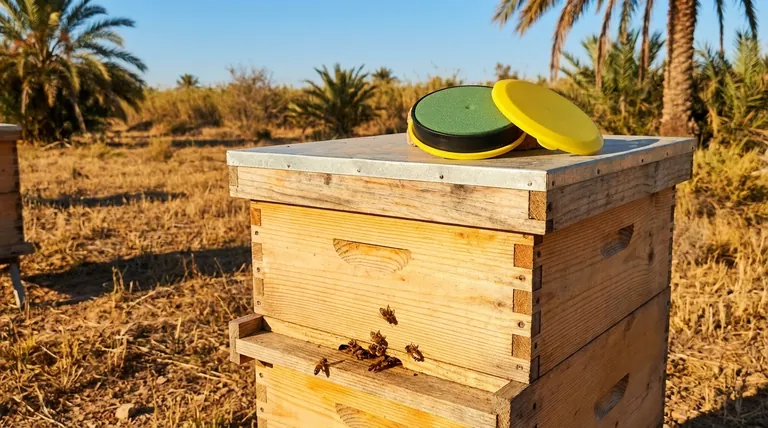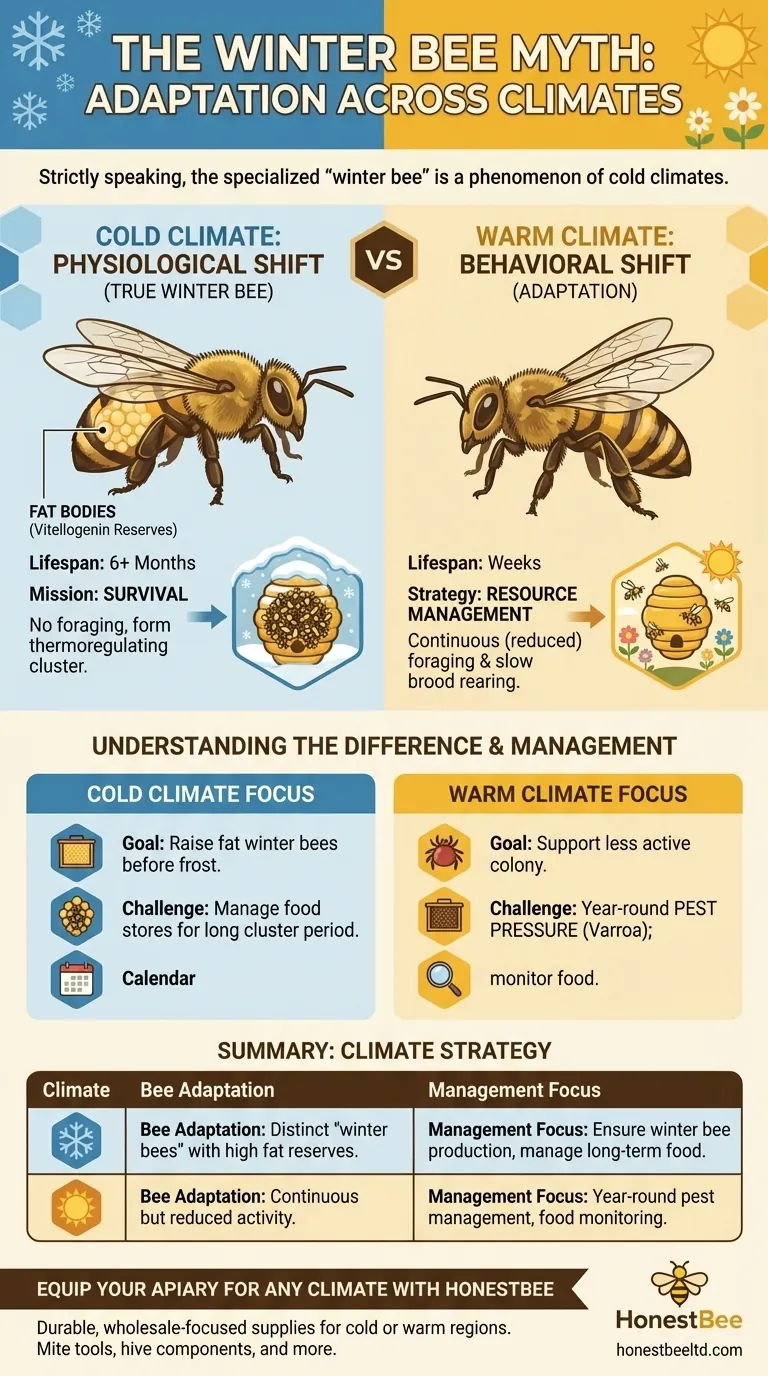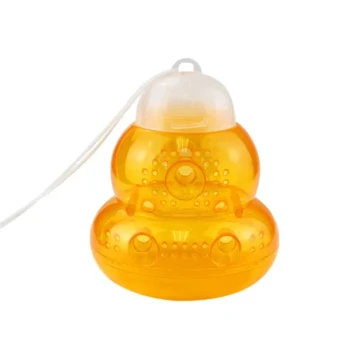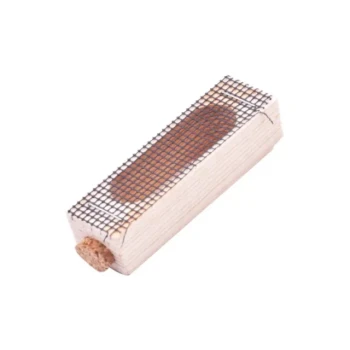Strictly speaking, the specialized 'winter bee' is a phenomenon of cold climates. In warmer regions, honey bee colonies adapt to the milder winter season with less dramatic changes. They may reduce brood production and the bees born during this time might live slightly longer, but they do not undergo the distinct physiological transformation seen in their northern counterparts who must survive months of freezing temperatures without forage.
The key distinction is not whether bees survive winter, but how. In cold climates, bees undergo a profound physiological change to create long-lived 'winter bees' for survival. In warmer climates, the adaptation is primarily behavioral—a simple reduction in activity and brood rearing—without creating a biologically distinct type of bee.

What Defines a "True" Winter Bee?
To understand the difference, we must first define what makes a 'winter bee' in a cold climate biologically unique. This is not simply a bee that happens to be alive during winter; it is a physiologically distinct individual.
A Shift in Physiology
The primary trigger for producing winter bees is the declining availability of pollen in late autumn. This environmental cue signals the hive to raise a final generation of bees that are built for endurance, not for work.
These bees develop large vitellogenin reserves, commonly known as fat bodies. This protein-rich substance acts as a food reserve and is a key factor in their extended lifespan, allowing them to live for six months or more, compared to the six-week lifespan of a summer worker bee.
A Different Mission
Unlike summer bees, who spend their lives foraging, building comb, and rearing young, the sole mission of a winter bee is to survive. Their brood-rearing glands are underdeveloped, and their primary job is to form a thermoregulating cluster around the queen, consuming honey to generate heat and keep the colony alive until spring.
Why Warmer Climates Change the Equation
In regions like Florida or Texas, the environmental pressures that create the need for a "true" winter bee simply do not exist in the same way. The colony's strategy shifts from long-term survivalism to short-term resource management.
Continuous But Reduced Foraging
Warmer climates rarely experience months of uninterrupted cold. Winter is characterized by cool periods interspersed with warm days, allowing bees to take cleansing flights and even find occasional sources of nectar and pollen.
Because foraging is not completely shut down, there is no need to produce a specialized generation of bees designed to live for half a year.
Continuous (But Slowed) Brood Rearing
With some resources still available, the queen's egg-laying slows down but often does not stop completely. This continuous, albeit reduced, production of new bees means the colony is constantly replenishing its population.
This eliminates the need for a single generation to carry the colony's genetic future all the way through to spring. The bees born in a mild winter may live slightly longer than summer bees, but only by a matter of weeks, not months.
Understanding the Trade-offs and Management
The absence of a "true" winter bee does not mean beekeepers in warmer climates can ignore the season. The challenges are simply different.
The Myth of an "Easy Winter"
A common mistake is to assume a mild winter requires no management. Colonies still face significant stress from fluctuating temperatures and reduced food availability.
Food Stores Are Still Critical
Even a less active colony consumes honey to fuel its cluster on cool nights. A sudden, unexpected cold snap can be more dangerous than a predictable deep freeze, as it can trap the cluster away from its food stores, leading to starvation.
Persistent Pest Pressure
Perhaps the biggest challenge in warmer climates is the continuous pest cycle. In the north, the broodless period of deep winter naturally breaks the reproductive cycle of the Varroa mite, the honey bee's most significant parasite.
In warmer climates, the presence of winter brood allows Varroa populations to persist and even grow, meaning mite management must be a year-round priority.
Making the Right Choice for Your Goal
Your approach to winter beekeeping must be tailored to your specific climate and the biological reality of how your bees will respond to it.
- If your primary focus is understanding bee biology: Recognize that "winter bees" are a specific physiological adaptation to prolonged, resource-less cold, not a universal winter trait.
- If your primary focus is beekeeping in a cold climate: Your goal is to ensure the colony successfully raises a generation of long-lived, fat-bodied winter bees before the first hard frost.
- If your primary focus is beekeeping in a warm climate: Your management shifts from preparing for a total shutdown to supporting a less active colony through a period of reduced resources and persistent pest pressure.
Understanding this fundamental difference in seasonal strategy is the key to effective beekeeping in any environment.
Summary Table:
| Climate Type | Bee Adaptation | Key Management Focus |
|---|---|---|
| Cold Climate | Produces physiologically distinct 'winter bees' with high fat reserves for survival. | Ensure colony raises robust winter bees before frost; manage food stores for long cluster period. |
| Warm Climate | No true winter bees; continuous but reduced brood rearing and foraging. | Manage year-round pest pressure (e.g., Varroa mites); monitor food stores despite mild temperatures. |
Equip Your Apiary for Any Climate with HONESTBEE
Whether you manage commercial apiaries in cold northern winters or warm southern regions, HONESTBEE provides the durable, wholesale-focused beekeeping supplies and equipment you need. From mite management tools to hive components designed for seasonal stress, we help you support your colonies' unique adaptations.
Contact our team today to discuss your seasonal needs and explore our wholesale catalog!
Visual Guide

Related Products
- Adjustable Formic and Acetic Acid Dispenser for Bee Mite Treatment
- Professional Galvanized Hive Strap with Secure Locking Buckle for Beekeeping
- Professional Bamboo Queen Isolation Cage
- Professional Grade Foldable Beehive Handles
- Black Plastic Beetle Barn Hive Beetle Trap for Beehives
People Also Ask
- How can beekeepers ensure their hives survive the winter? A Guide to Colony Survival
- What are the symptoms of Varroa Mite Syndrome (VMS)? Recognizing the Signs of Colony Collapse
- What should be done after treating a colony for varroa mites? A Step-by-Step Guide to Verifying Success
- What are phoretic mites? A Beekeeper's Guide to Monitoring Varroa Infestation
- What is the optimal time for varroa mite control in nucs? Maximize Efficacy with Perfect Timing



















